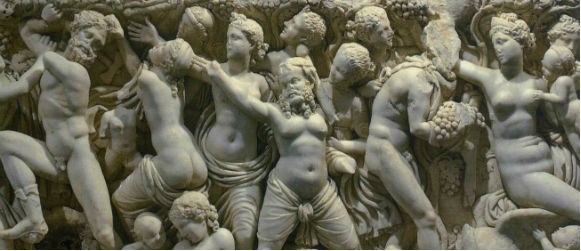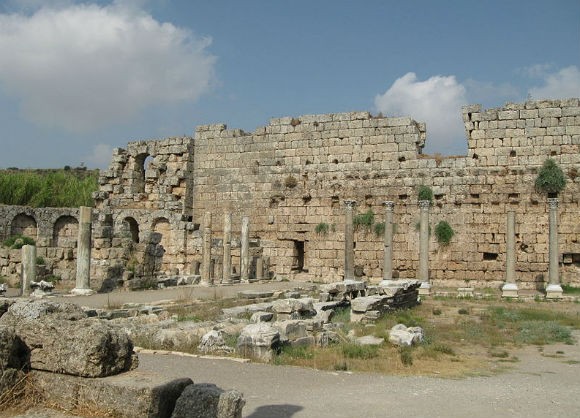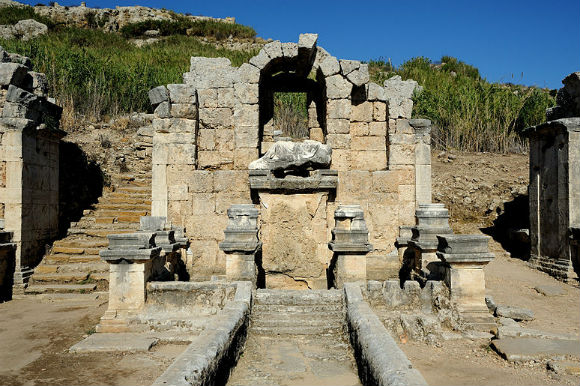Perga was an old city even in the first century. Its name (which is not Greek) indicates that its origin dates from pre-Greek times. Alexander the Great passed through it twice while the Pergaeans offered no resistance to him although it was a walled city with a citadel. In Roman times the main streets were over twenty-one meters wide. They were lined with Ionic colonnades and a water channel ran down their center in a series of small waterfalls as in Antalya today. Behind the colonnades stood the shops. Of the early buildings the stadium and the theater have survived the ravages of earthquakes and wars with the least damage. In fact this stadium which could seat about fourteen thousand people is one of the best preserved in Turkey.
The temple of the Pergaean Artemis according to a writer of the time was “a marvel of size, beauty, and workmanship.” Its location has yet to be established; it may have been where there are now ruins of a Byzantine church on a hill to the southeast of the city.
Perga is on a rise not far from the Cestrus River which was navigable In Paul’s time. It was not a seaport in terms of Its being directly on the Mediterranean even then, but rather it was more easily defended where it was: its distance from the open sea made it less vulnerable to piracy.
Two people stand out among the early residents of Perga. Apollonius was a third century B.C. astronomer and mathematician who believed that the movements of heavenly bodies in the universe were explainable by orbits within orbits: that the moon went around the earth as the earth went around the sun. He was much ahead of his time in his theories of astronomy, so much so that the ideas had to be rediscovered during the Renaissance. Plancia Magna was unusual for a second century A.D. woman: she held the highest city office during her life, that of demiurgus. She must have been well-to-do for a number of inscriptions record her gifts to the city.
Paul and Barnabas went through Perga on their way to and from Antioch on their first journey (Acts 13:13, 14:25). John Mark was with them at first but left them at Perga to return to Jerusalem. The reason for that must have been such that Paul doubted his commitment to the cause. Later when Paul and Barnabas were about to start on their second journey from Antioch they had a sharp dispute over his worthiness. Paul refused to have him go along, so John and Barnabas went to Cyprus while Paul chose Silas to accompany him.
Paul talks in II Corinthians 12:7 and in Galatians 4:13-14 of bodily illness that brought him to Galatia the first time. It may have been on that account that he did not stay long in Perga the first time. Whatever the illness was, it seems to have improved in time in the dry mountain air to the north.
The second theory of why they did not stay long in Perga is that their interview with Sergius Paulus, the proconsul of Cyprus, had made them want to hurry to the Roman colony in Antioch of Pisidia. This interpretation may lay too much stress on the lasting importance of that meeting with a cultured Roman who could have been more interested in the pursuits of the mind than the salvation, in Christian terms, of his soul. It is interesting, however, that this is” the point in Acts (13:9) that Luke begins to call Paul by his Roman name, not his Jewish “Saul”.
On their return they did stay in Perga long enough to preach and talk with people there. Nothing else is told about the city or their time there.
Perga,






Its very close to the town of Antalya.The well preserved Roman baths were very interesting with their caldarium intact.There was also the huge agora,huge Hellenistic city gate and a very interesting small market selling souvenirs.
Perge is really a great place to visit. Of course Turkey and the Middle East have plenty of Roman ruins but I think that Perge is there in the top attractions. As usual you need a bit of culture to understand and "see" the Roman town but at the end of the day everything is there: the Agora and the…
Perge is situated a little outside of Antalya and is a quite large site with various interesting sites to watch. When we arrived to Perge we passed the theater which unfortunately was closed to the public. We then came to the "city" itself which was large with a lot of interesting ruins. They had quite large public baths and a…
Visited Perge whilst on a trip to Aspendos. Well worth the visit, loved wandering around the site. Lots to see take your camera and drinks. Like most of these places it can get hot.
Had a guide so we did not miss anything, great to hear about the history of the place.
Fantastic what they achieved 1000 BC. Perge is close to Antalya, and we rented a car and combines Perge with Kudunlus waterfalls and Side
We didn't take a tour but, with help from the tourist office in Antalya, went to the little town of Aksu by the inexpensive local bus (check number and stopping-place with tourist office – route could change and create confusion – but buses run about every 10 mins. and the journey to Aksu takes about half an hour) and then…
If you are travelling along the coast in Turkey, you will come across many ruins, but Perge is one of the top spots. The place is quite large, there are well preserved ruins aplenty and it's a thrill to be able to walk anywhere without any restrictions. Be prepared to suffer from the heat, though (especially in the summer), as…
This is a hugh site with on going restoration and excavation. The ampitheatre is closed at the moment but there is still loads to see. Visit Antalya museum to see the beautiful statues they have excavated. If your taking your Sat Nav, ignore it when you get off the D400 and follow the signs instead!!
Excellent site. Be careful walking around, especially the hippodrome; take the entrance from the parking lot.
Good visit and lots to see there. Lots of ruins of Roman buildings still visible for what they had been as not been disturbed or stones redistributed as in England. Much more complete and gave a good insight into what had been there.